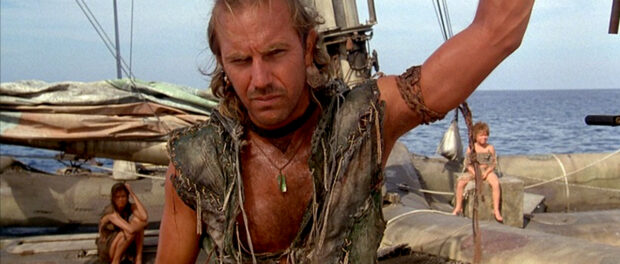Waterworld (1995)
[7]
Even when a movie doesn’t quite come together, I sometimes admire the effort and ambition so much, that I have to give a little extra credit. Waterworld is one of those movies, especially after viewing the extended ‘Ulysses Cut’ of the movie, which runs nearly three hours long and fleshes the characters out a bit better than the theatrical cut does.
Waterworld takes place in a distant future in which Earth’s polar ice caps have melted and humanity has adapted by banding together in small floating cities scattered across the oceans. Kevin Costner stars, reteaming with his Robin Hood: Prince of Thieves director, Kevin Reynolds. Costner plays a mutant with gills behind his ears. He uses his ability to swim deep down to the ruins of human civilization. He collects artifacts and sells them at trading outposts. It’s a lonely life, and he’s very much a loner character at first.
After a trading colony locks him up and sentences him to death for his mutation, Costner is rescued by a woman (Jeanne Tripplehorn) who asks for protection for her and her adopted daughter (Tina Majorino), a girl with a mysterious tattoo on her back. The trio barely escape a thrilling attack by the Deacon (Dennis Hopper), the faux-religious leader of marauders who terrorize the seas. The Deacon pursues Costner and his two wards, convinced the girl’s tattoo is a map to rumored ‘Dry Land’. Over the course of the journey, Costner’s selfish heart begins to melt for the girl — enough that when the Deacon finally kidnaps her, he’s willing to fight for someone other than himself.
Waterworld‘s first hour is its most interesting, as we learn the new realities of life on the water. Costner is introduced peeing into a contraption that extracts water from urine. And when he’s robbed while scavenging under water, the thief values a small potted lime tree more than anything else. The first hour is also the most exciting. The Deacon’s attack on the floating city is impressively executed, with life-size floating sets and stunt-work involving jet-skis that jump the city walls. James Newton Howard’s score is a riveting, swashbuckling one with moments of austere beauty and exoticism. The costumes are fascinating, too, making use of plastic and recycled materials in a way we’ve never seen before.
I have to give Costner some credit here. He’s well suited to playing a gruff loner of few words. At times he even reminds me of Errol Flynn when he’s swinging around on his ship. The screenplay keeps him in ‘mean’ mode a little too long, though. His antagonistic relationship with Tripplehorn and Majorino, who can’t help but get in his way and interfere in his lifestyle, gets tiresome. I think if he softened a little earlier in the movie, it might have given more emotional weight to the third act. That third act doesn’t measure up to the thrills of the first one, unfortunately. But Dennis Hopper almost makes up for it as the Deacon. He’s a funny villain with lines like, “He’s a turd that just won’t flush.” His lair is none other than the infamous Exxon Valdez — still floating after spilling millions of gallons of crude oil in 1989.
Even though the film is often silly, peaks early and drags a bit in the middle, I found myself really enjoying Waterworld upon a recent rewatch. It was the first time I’d seen the extended cut of the movie, and I think the extra 45 minutes make a noticeable difference. I cared more about Costner’s character and I cared more about the world-building. I originally rated Waterworld a 5 out of 10, but I’m upgrading it to a 7 now. Maybe I’m less critical as I get older, and maybe the ‘Ulysses Cut’ is truly a better version to see. Probably both are true.
With Michael Jeter and Jack Black.
Oscar Nomination: Best Sound

